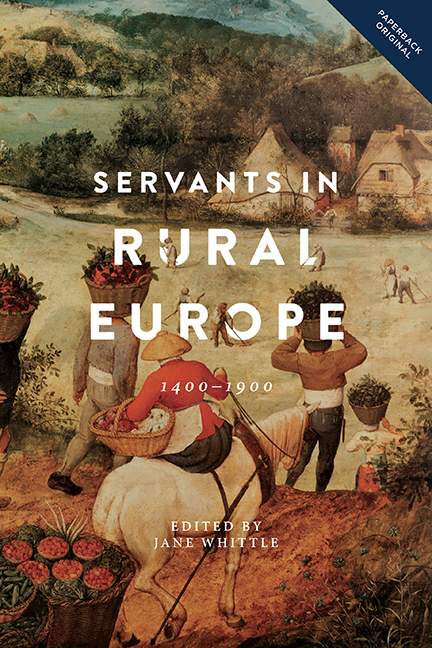Book contents
- Frontmatter
- Contents
- List of Figures
- List of Tables
- Note on Terminology
- List of Contributors
- Introduction: Servants in the Economy and Society of Rural Europe
- 1 The Employment of Servants in Fifteenth- and Sixteenth-Century Coastal Flanders: A Case Study of Scueringhe Farm near Bruges
- 2 The Institution of Service in Rural Flanders in the Sixteenth Century: A Regional Perspective
- 3 A Different Pattern of Employment: Servants in Rural England c.1500–1660
- 4 Female Service and the Village Community in South-West England 1550–1650: The Labour Laws Reconsidered
- 5 Life-Cycle Servant and Servant for Life: Work and Prospects in Rural Sweden c.1670–1730
- 6 Servants in Rural Norway c.1650–1800
- 7 Rural Servants in Eighteenth-Century Münsterland, North- Western Germany: Households, Families and Servants in the Countryside
- 8 Rural Servants in Eastern France 1700–1872: Change and Continuity Over Two Centuries
- 9 The Servant Institution During the Swedish Agrarian Revolution: The Political Economy of Subservience
- 10 Farm Service and Hiring Practices in Mid-Nineteenth-Century England: The Doncaster Region in the West Riding of Yorkshire
- 11 Dutch Live-In Farm Servants in the Long Nineteenth Century: The Decline of the Life-Cycle Service System for the Rural Lower Class
- 12 Rural Life-Cycle Service: Established Interpretations and New (Surprising) Data – The Italian Case in Comparative Perspective (Sixteenth to Twentieth Centuries)
- Select Bibliography
- Index
- People, Markets, Goods: Economies and Societies in History
3 - A Different Pattern of Employment: Servants in Rural England c.1500–1660
Published online by Cambridge University Press: 18 April 2018
- Frontmatter
- Contents
- List of Figures
- List of Tables
- Note on Terminology
- List of Contributors
- Introduction: Servants in the Economy and Society of Rural Europe
- 1 The Employment of Servants in Fifteenth- and Sixteenth-Century Coastal Flanders: A Case Study of Scueringhe Farm near Bruges
- 2 The Institution of Service in Rural Flanders in the Sixteenth Century: A Regional Perspective
- 3 A Different Pattern of Employment: Servants in Rural England c.1500–1660
- 4 Female Service and the Village Community in South-West England 1550–1650: The Labour Laws Reconsidered
- 5 Life-Cycle Servant and Servant for Life: Work and Prospects in Rural Sweden c.1670–1730
- 6 Servants in Rural Norway c.1650–1800
- 7 Rural Servants in Eighteenth-Century Münsterland, North- Western Germany: Households, Families and Servants in the Countryside
- 8 Rural Servants in Eastern France 1700–1872: Change and Continuity Over Two Centuries
- 9 The Servant Institution During the Swedish Agrarian Revolution: The Political Economy of Subservience
- 10 Farm Service and Hiring Practices in Mid-Nineteenth-Century England: The Doncaster Region in the West Riding of Yorkshire
- 11 Dutch Live-In Farm Servants in the Long Nineteenth Century: The Decline of the Life-Cycle Service System for the Rural Lower Class
- 12 Rural Life-Cycle Service: Established Interpretations and New (Surprising) Data – The Italian Case in Comparative Perspective (Sixteenth to Twentieth Centuries)
- Select Bibliography
- Index
- People, Markets, Goods: Economies and Societies in History
Summary
Ann Kussmaul's classic study of servants in early modern rural England was published in 1981. It built upon the earlier work of J. Hajnal, who mapped out the distinctive features of life-cycle service in north-west Europe, and Peter Laslett, who demonstrated the presence of large numbers of servants in early modern England. Although Laslett and Kussmaul aimed to discuss the whole of the early modern period, the sources they used were heavily weighted to the period from 1660 to 1830. This chapter argues that as a result, they failed to identify important changes in the pattern of servant employment over time in England. Both Laslett and Kussmaul made use of a set of one hundred ‘household listings’ describing the composition of households in particular communities, which were identified and transcribed by the Cambridge Group for the Study of Population and Social Structure. Only five of these dated from before 1660, and three of those related to towns. The main source used by Kussmaul to map the incidence of service in the period before 1660 was the seasonality of marriages recorded in parish registers, which could be measured from the 1550s to the 1830s. She argued that changes in the seasonality of marriage reflected levels of servant employment as many servants married just after leaving service: in areas of southern and eastern England where arable agriculture dominated, servant contracts began and ended at Michaelmas (29 September) after the grain harvest. Thus the prevalence to October marriages indicated the incidence of service over time.
Using this evidence Kussmaul proposed that the incidence of service ‘did not remain fixed, but rose and fell in two major cycles from c.1450–1900’. In the first cycle October marriages peaked around 1560, before declining gradually to the 1630s, and then dipping sharply during the Civil War years of the 1640s and 1650s. In the second cycle the incidence rose quite steeply in the late seventeenth century to a peak in 1740, before declining again over the following century. Kussmaul argued that the underlying cause of these cycles were demographic. As population increased in the sixteenth and eighteenth centuries, so did the cost of living, and real wages fell, as can be seen clearly from the day wage rates for male agricultural labourers compiled by Gregory Clark.
- Type
- Chapter
- Information
- Servants in Rural Europe1400–1900, pp. 57 - 76Publisher: Boydell & BrewerPrint publication year: 2017



